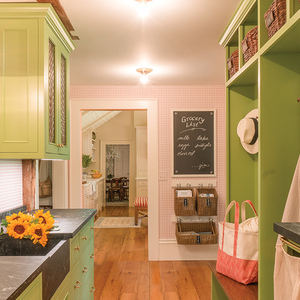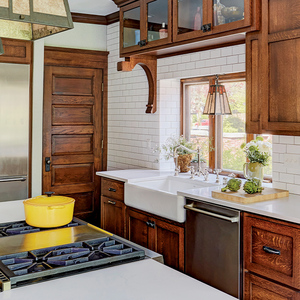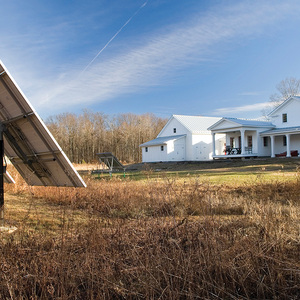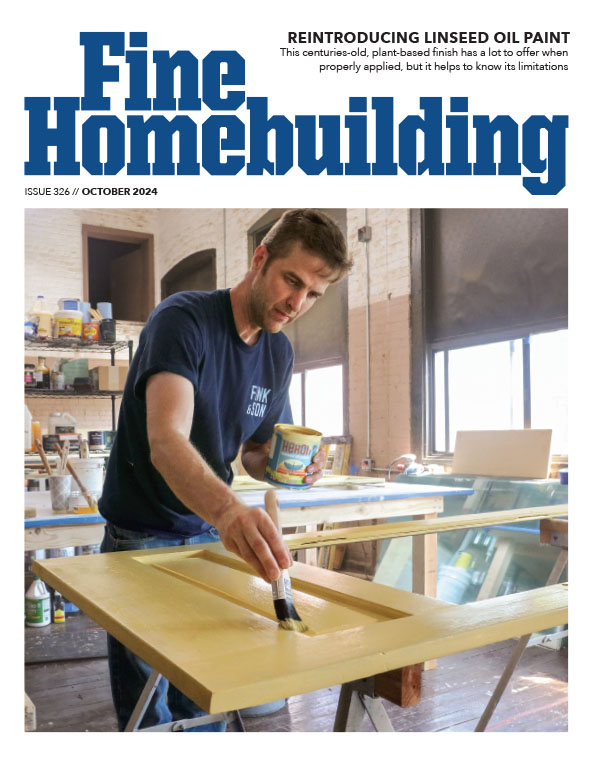*
Got into a discussion with the local lumber yard guys today over kiln dried studs. Seems as though he uses green lumber exclusively and doesn’t bother with kiln dried studs in crucial areas at all. He does it to save money.
I like using kiln dried studs for areas which will have some critical viewing or where more precise tolerances are needed, like for tile showers and wall tile.
Where and when do you use Kiln Dried Studs?



















Replies
*
Scooter,
We use kiln dried lumber everywhere and all the time. I wouldn't dream of using green lumber anywhere for building a house. Not even for blocking.
Ed.
*That green stuff is why half the houses around here have wavey walls. kd or nada thank you.
*Around here the framers refuse to use anything but S-GRN even when my specs say S-DRY. They insist that it doesn't nail as well as S-GRN.So which is it guys? I'm frankly surprised at the above.Jeff
*Kiln dried for me. I don't need the call backs.
*I use kiln dried white pine for anything that needs to be straight, and not carry any load. Southern Yellow Pine is not available here in kiln dried, only white pine. And the white pine we get ain't structurally strong enough for a load bearing structure.James DuHamel
*I think it's probably more of a regional thing. You cannot buy green or partially dried lumber in my area, and to be honest, I'd never heard of it until I saw an article in the Journal of Light Construction about six months ago about some strange bug infesting all these developments in Washington...gist of the article was that kiln-drying would have killed them. Anyhow, SPF KD is all we got here.
*The bug thing is important, although I have built with green timbers. They do nail easily and supposedly shrink around the nails for a better grip. They're also heavy, slippery, it's harder to see a pencil line, and like Steve said they move more as they dry.Mike
*
View Image © 1999-2001"The first step towards vice is to shroud innocent actions in mystery, and whoever likes to conceal something sooner or later has reason to conceal it." Aristotle
*In the last twenty years - I used green lumber for my shop which is unfinished walls - exosed studding. Using it for a customers home would be professional suicide.
*We can't even buy green lumber around here. I really can't see trusting anything that wet not to shrink and cause major problems.Ed.
*It's got to be a regional thing. We frame with S-grn lumber all year round and use it everywhere. Even the local truss companies use it in their trusses. I have tried kiln dried a few times but at least where I am the load always has a high percentage of twisted and bowed ones. A lot of the houses I frame sell in the $500,000 to $750,000 range so the use of green douglas fir as a framing material can't be all bad.
*Marshall,I guess the proof is in the house. We use KD #2 Doug Fir for framing and KD #1 Yellow Pine for joist and such.I didn't know anyone used green lumber.I guess I learn something new everyday, but I'm still not gonna use green lumber to frame with. At least not in Dallas.Ed.
*Ed, the amount of information I don't know about construction far exceeds what I do know. I have never heard of #1 Yellow Pine being used as a joist or rafter material. I have over 20 years in as a framing contractor and I'm constantly learning and that is as it should be I suppose. No question that the green stuff moves a lot as it dries, that is why we have lots of Makita planers and cardboard furring strips that we use in our attempt to achieve perfection in an imperfect world.
*Marshall,In Texas, yellow pine seems to be the wood of choice for long horizontal spans. Douglas fir for everything else. Maybe our high humidity year round is why these woods are speced for our area.However, I'm seeing a lot more engineered wood these days. Finger joint studs, TJI and trim joist, etc. I'm fixing to start a 6000 sqft house that framed all metal. Trim mans nightmare.Ed.
*Amazing. I'm always learning something from you guys. I've always framed new stuff with green, and remodel stuff with KD. I've had both kinds tweak on me.I can theoretically see advantages to building a new house with KD. I'd like to try it. Its not that much more expensive.
*Scooter, can't imagine everyone not wanting to use dry studs (or joists) whethter they're kiln dried or air dried doesn't matter. If the wood is over 19% moisture content (15% was my standard but had to compromise as no one carried such) it will shrink as it ages and dries leaving one with gaps at mouldings, nail pops, binding windows and doors, etc. When times are busy and contractors can't wait for deliveries it is hard to find anything better than surface dried studs in the Mid Atlantic area. Firmly believe the popularity / availability of the man-made stud is closer than we think; SPF 2x4's will be obsolete before I retire !
*In CA and CO I've not used or seen anything other than kiln dry lumber for framing. You guys who use wet lumber...ever have trouble with drywall absorbing that moisture and getting mushy? or transfering a stain to the good side?
*Both are sold here; at the yard I go to most, the KD is undercover, the green stuff isn't. I don't really know what others are using; for the limited amount of framing we do (all remodeling), it's all KD (and it's all SPF). Only buy green stuff for temporary shores or things like that, that won't become part of the house.Agree on the man made stud coming soon to a yard near you thing.
*GDF...doug firI grew up using this and only when I got older and travelled some did I experience other materials.What a difference though! I believe the Douglass Fir must grow slower and have tighter annular rings. Its heavier and harder than the other framing species I've worked with. I never heard of using green wood to build with. The end must be near! God help us!
*We don't see green lumber here either (upstate NY).For those choosing between the two, what is the price difference 5% 10% 25%....?
*Could someone please explain what you mean when you say "green"? What does the grade stamp say?We've been using "SDry" (surface dry - I think it is something like 20% on the surface)Doug Fir here in Washington for at least the past 22 years. Back in the late 70's the oldtimers used to have pretty heated arguments over lunch about which was better framing lumber, SDry Fir, or KD Hemlock. We started seeing KD SPF (Spruce, Pine, Fir) studs in the mid 80's, but they weren't near as strong as DFir or Hemfir (Hemlock, Alpine Fir mixture). The main trouble is most of the good DFir gets shipped out of here because they can get top dollar for it and the price of transportation is more easilly absorbed. Still, I like KD Dfir studs, hemfir plates (cause they don't split so bad when you nail the last stud or at intersecting walls or corners, Dfir Sdry beams, joists, and rafters (can't get the big stuff KD). Although I have to say, I really like TJI's for joists and am going to use them for rafters on my next roof framing project.
*Green is wet 2x4's. Cut 'em, rack 'em, and stack 'em. Kiln dried are the same wet studs, but thrown into a hot kiln to bake off the moisture. The result is a lighter, less shrinking product.We see kiln dried studs here, but everything over a 2x4 is green. So green (wet) 2x6's, 2x8's and 2x12's. I suppose one could special order the other framing lumber, but no one uses kd joists and rafters here.
*So what does the grade stamp say on this "wet" lumber you're talkin' about, Scooter?If a sling of KD gets rained on for a week, do you call it "green"?
*its says s grn
*Now I'm no expert jim but I think it has a lot to do with the cellular structure of the wood. green wood is not just water content but also sap. once you kiln dry or even air dry for that matter the moisture out of wood the sap and the cell structures harden or almost cure. picture concrete, before it cures and after it cures. if it rains on concrete after it cures it gets wet but it will dry out and not disolve. did that make any sense? I'm not sure cause I'm sitting here scratchin' my own head.
*Sorry I said anything, I don't know this "s grn". Does that mean it's anybody's guess what the moisture content might be? I wouldn't want to use that for anything, definately not for studs.Steve, I was just trying to get the terminology straight. In my mind there is a big difference between "green" and "wet". And there's a big difference between lumber going through a kiln and having moisture baked "off" of it, and having moisture baked "out" of it. In fact, I think many kilns actually use steam to dry lumber, but I'm sure Lee Grindinger, or someone else who knows more about kilns than me will come along and explain. Regardless, it's all about moisture content, that's why we have standardized grading systems.
*Ok, I was just stabbing at what seemed to make sense based on your question of is a sling was left in the rain green or wet. The next time I talk to my sister I'll see if she knows. she's a paper engineer and deals with wood, moisture content and all of that wonderful stuff. if I find out and you're interested I'll post it or email you.
*Well, I'll take a shot at it, off the top of my head....at least I can tell you what we see around here. I'd have to go look at the grading rules...I have all that for hardwood lumber, but I'm not sure what I have for softwood.Wet vs dry...say you cut a tree and mill it into lumber. At that point the moisture content (m.c) of the wood will be very high (according to my kiln operators manual, the average green m.c's (mixed; heartwood and sapwood) for balsam fir is 118%, pines are 51-90%, black spruce is 77%).Some of that moisture is in the form of 'free water' (in liquid and vapour form in the cell cavities), and some in the form of 'bound water' (contained in or asscociated with the cell wall structure). Some of that moisture (the free water) will begin to evaporate or whatever....it departs the lumber through the process of air drying. At the point where the free water is all gone, you have the 'fiber saturation point (FSP)'. To get rid of bound water, you usually need to boost the process, like in a kiln.Bear with me....at and above FSP (very approximately 22-30% m.c), there is little or no change in the dimension of the wood...no swelling or shrinking (the scinetists generally use 30% at the point where some shrinkage begins....this is where it becomes important to us, 'cause we want the shrinkage to happen before we build it into walls and stuff, right?).I was taught wood is considered 'dry' for construction purposes below 18% m.c (my manual uses 15% as an approximate final destination for construction lumber)....FSP is 22-30%. Wood, when built into anything, is going to try and achieve (well, it won't try, it will) Equilibrium Moisture Content (EMC), where it is in balance with it's environment....if the environment is drier than the lumber, whatever free water is still there will be driven off...if you frame up a house with green lumber at 30%, and the lumber is going to eventually dry....cause you cannot stop it finding it's EMC.....to 15-18% m.c, obviously there is a lot of room there for dimensional change (shrinkage). The manual gives the example of a stud, drying from 30% m.c ('normal assumption'), to 19% ('target m.c')....it will shrink about 4% in volume, more if the lumber gets drier. You decide if that is important enough to pay more for KD.The thing about KD lumber is....once all the free water is gone, and you start geting rid of bound water (remember, for hardwood lumber, it gets dried down to 6-10% m.c, so a lot more bound water is being driven off than is the case for construction grade lumber), getting rained on isn't going to make much difference, because the change happens at the cellular level. KD isn't all that dry, but it's worth it to me to pay the premium to make sure as much shrinkage has already happened before I use it, but then I don't frame houese, or do anything in the way of new housing.That's all very dry; sorry. But those are the key concepts: moisture content, fibre saturation point, and equilibrium moisture content. If you get a grip on those, you've got a good start.
*We use a framing stud here called "Temple Purple". It has a moisture content of about 18%, and each end is soaked in parafin (wax) to keep it from wicking water. It is straight as an arrow, and very strong. It is #2 SYP.It is pre-cut, and is made by a company called "Temple-Inland". Now this stud is NOT grade marked as kiln-dried, surface dried, or s-grn. Is this considered "wet" lumber, or "dry" lumber? Grade markings don't distinguish. It is only grade stamped as #2 Prime.Anyway, that's what we use for framing.James DuHamel
*ArdianAFAIK, I think that you got it fairly close.But you don't need a kiln to get rid of bound moisture. But it takes a long time to do it by air drying. The old rule of thumb is 1 year per inch of thickness. Hoadly says that it is often much less, but still too long for production construstion lumber to sit around.Blue S-DRY is not surface IS dry. It means that was surfaced after it was dry. I believe that anyting under 19% is "dry" for construction lumber.If it gets wet the MC will go up, but you can't ever get the free water back into it. But, unless it soaks for days, the amount of moisture that it gains will be "small" and it will dry out again in a few days or weeks
*Thanks Adrian. Very clearly explained, and not at all dry. Does this "bound" moisture EVER leave the wood without man's help, or is it trapped until the cell structure breaks down? Does all that equilibrium seeking moisture shifting happen where the free moisture was, or does the bound moisture fluctuate too?
*Some of the bound water will leave without a kiln....I think you can air dry down to 12-15% (people may debate the numbers), which is well below the fiber saturation point. To get lumber down to what furnituremakers want (6-8% in most of North America, a little higher in other parts), you need a kiln. The EMC is constantly going on, everywhere, with every piece of wood in the world....each piece is trying to pick up or give off some moisture in order to be in balance with the environment....that's why we finish furniture and cabinets, to try and slow down the process and minimise movement and stress on woodwork. Same thing with framing lumber....if you build green lumber into a house, it's going to dry down to where it is in balance with the environment, and then it will move up and down a certain amount to keep in balance. But the dryer the lumber is going in, the less shrinkage you will experience as the lumber dries out (like you guys didn't know that). At what m.c green lumber would naturally settle at is regionally influenced...it's not going to be the same in AZ as it is for you and me.I just found a chart here, by the way, that gives the volumetric shrinkage for different softwoods used in Eastern Canada, from green to airdry (which they call 12% m.c)...it ranges from 3.8% (eastern white cedar), to 8.1% (western hemlock). Most are in the 5-7% range.
*Okay, let's say I use kiln dried material to build a...let's say a desk. When I start milling, it's 6-8%. From the moment I bring it to my shop, for the rest of it's life, it is trying to reach ambiant moisture level, whereever it's at, right?So if the ambiant moisture level in...let's say Saskatoon, varies from 12-20%, depending on the season, isn't that desk going to absorb moisture and swell?So I guess folks need to know what the ambiant moisture levels are before they build something for a certain climate, or even a certain building, don't they? And various woods and grain patterns swell and contract in predictable ways, right?
*JimYou always need to think about wood movement. In cabinet work it is cross grain connections. And of course clearances for doors and drawers.The EMC in wood in not the same at the relative humity, but it does very, in a non-liner fashion with relative humidty."Understanding Wood" by Hoadley has a lot of details about this. It has a chart of the contigous 48 states showing summer and winter relative humidities and the EMC of wood for summer and winter. Summer Winter (RH/EMC)Portland 40/8.5 35/8.5New Orleans 60/13 52/12Washington DC 53/12 35/7.8Idaho is about 5-6 EMC.
*Back in Jersey, and from what I've seen in S.W. CT as well, the standard is SGrn D.F. #2 or better. The only dried material I could get in Jersey was KD SPF. That was god-awful stuff, and almost no one used it even for studs. I've seen Doug fir so full of water that it squirted when hit with a hammer.In our climate, I don't think KD lumber makes much sense. How many houses get through construction without going through a couple of good rains? One in ten? I'm starting to see some finger-jointed studs now, and they make me hopeful. I think that studs with lots o' knots went south more than just plain wet ones. Take out the knots, and I'd expect the stud to stay straight. I've noticed some differential shrinkage on opposing sides of finger joints, but all that I've seen is on the order of 1/16 in.; inconsequential in framer's terms.Andy
*I always laugh when i see pressure treated lumber that is stamped with k-dat 19(kiln dried-19%mc) cause its always soaking wet..kiln dried studs are nice to my aching back..but if they are spf its not even worh using..most of the time they start to warp as soon as you break the bands..doug fir on the other had is alot more to my liking jason
*eeek... youse guys are flying on instruments..b as for framing lumberS-dry means just as stated..it was SIZED after it was dried to below 19%S-GRN means it was sized at a moisture content in excess of 19%but it was still stickered and racked in the lumber yard until it came to 19%..KD means it was mechanically dried to 12% and PT, in order to accept the treatment process of the CCA, it had to be dried to 12% first... then it was PRESSURE TREATED with the liquid CCA.. which makes it wet again... but .. as ADRIAN said...once the material is dried to 12% the cellular structure changes and it will not return to it's GREEN stae of moisture again... if it is subjected to continuous moisture in the prescence of oxygen at the right temperature it will just ROT...or you could look it up...as for S-GRN... i will have a lot less rejects for joists and rafters than i will if i'm using KD..but i will have more shrinkage....so i tend to go with the others that suggestS-GRN or S-DRY for new construction...and KD for remodeling...accepting more twisting because they tend to use more juvenile wood around here for KD..the best framing you can get here would still be DF S-DRY # 1 & #2.....HEM -FIR would be more readily available..and KD is crowding both of them out....b but hey , whadda i no ?
*
Got into a discussion with the local lumber yard guys today over kiln dried studs. Seems as though he uses green lumber exclusively and doesn't bother with kiln dried studs in crucial areas at all. He does it to save money.
I like using kiln dried studs for areas which will have some critical viewing or where more precise tolerances are needed, like for tile showers and wall tile.
Where and when do you use Kiln Dried Studs?